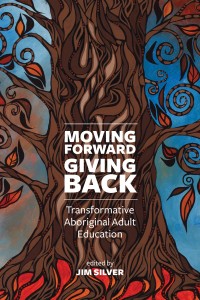Review in The Canadian Journal of Native Studies XXXIII, 2 (2013)

Moving Forward, Giving Back
Transformative Aboriginal Adult Education
An informative and timely text, Moving Forward, Giving Back: Transformative Aboriginal Adult Education deals with the challenges and successes experienced by adult Aboriginal learners in urban educational programs and the transformative power of such. Although the book’s examples and experiences are set in Winnipeg, the text rightfully acknowledges that the principles and practices herein “are almost certainly applicable…to fit local circumstances…all across Canada” (11-12). The text gives a large voice to Aboriginal people themselves: learners, teachers, administrators. Readers thus hear, firsthand, voices of those at the very center of the transformative power of urban adult Aboriginal education. The text is divided into easily identifiable and logical sections. Chapter One provides a summary overview of the topic at hand, including and introductory discussion concerning poverty, community development, decolonization, relevant curriculum, and social change vis-a-vis adult education amongst the urban Aboriginal population. Chapters Two, Three and Four are composed of case studies which explore the background and experience of a group of Aboriginal people who have not had a good experience with education or with life in general but who are now seeking such as adults. Chapters Five through Ten examine different educational programs that have or are attempting to make a difference amongst the Aboriginal population of urban Winnipeg. The experiences in the early chapters are particularly poignant, as they highlight the often dreadful experience of Aboriginal learners in residential school, public school, and in post-secondary settings. These sometimes heartbreaking stories will resonate with an older generation of Aboriginals who went through similar experiences, but it will also assist those who currently work with or for such people. Violence, racism name-calling, and low expectations seemed to be par for the course for these learners, in school and in life. Particularly encouraging , tough are the stories of eventual success; they are now “giving back” to their families and communities in various ways. This text should thus be required reading for those who work with Aboriginal people in any educational context in Canada and who know, or should know, that adult education is often an intermittent journey. The following epitomizes this knowledge and should be posted near the desk of teachers who work with adult Aboriginal learners: “Good adult educators don’t give up on people, and are sure to encourage people and say ‘Come back again when you’re ready.’” (36). If there is one lesson to be taken from this book, this is it. But there are others. Another is that”success” in education means more than mere program completion and a job. For Aboriginal people, it’s also an incredible “transformational” and life-changing journey of personal development, relationship-building, and healing (55-56). The importance of having Aboriginal content in courses/programs, having the proper student supports in place, and the realization that education leads not only to personal but to community development and transformation are all stressed as well, especially in the later sections of the text which highlight specific urban educational programming. For this reviewer, the most relevant and interesting section was Chapter Eight, which highlights the Beginning University Successfully program at the University of Winnipeg. This pre-university program is designed to prepare Aboriginal people who feel unready or unqualified for post-secondary studies for life as successful university students. I read this information very carefully, as my own university has such a program in place. It, too, has faced challenges, trials, tribulations, and successes similar to what I read about in this chapter. If readers wish to learn something about these programs - what works, what doesn’t, what kinds of students enter such, shy some don’t succeed and why others do - then this is the chapter to study. I found it the most interesting one in the text, as it encapsulates what is discussed almost everywhere else. A minor critique regarding this tome is that photos of some of the participants and/or programs at work would have provided some visual punch to the issues under discussion. Such can be arrows straight to the heart as human faces give extra meaning to poignant text and stories. But such is to quibble. A few notable texts have recently dealt with issues concerning Aboriginal post-secondary education, urban and policy issues, and the regeneration of modern Aboriginal peoples while respecting and preserving the past - i.e. educational decolonization and transformation. Dancing On Our Turtle’s Back (Arbeiter Ring, 2011) by Leanne Simpson, Urban Aboriginal Communities in Canada (Thompson Educational, 2011) edited by Peter Dinsdale, Jerry White, and Calvin Hanselmann, and the older The New Buffalo: The Struggle for Aboriginal Post Secondary Education (University of Manitoba Press, 2006) by Blair Stonechild, are three examples that come to mind. But for readers specifically wishing to learn about current urban Aboriginal adult education - including the background of learners in existing programs, best practices, and the overall power of personal and community transformation through education - then Moving Forward, Giving Back: Transformative Aboriginal Adult Education is the text for you. - William G. Lindsay, Office for Aboriginal Peoples, Simon Fraser University

